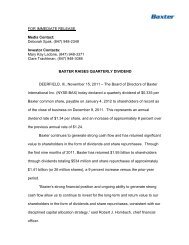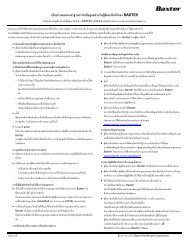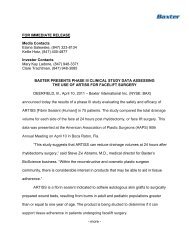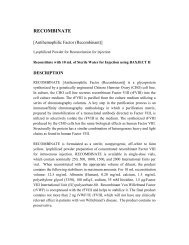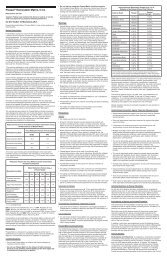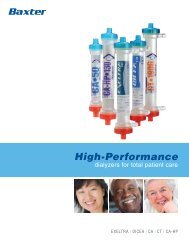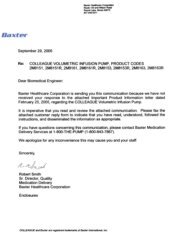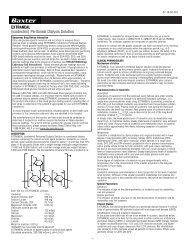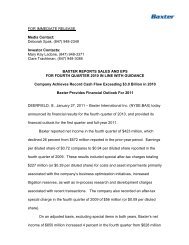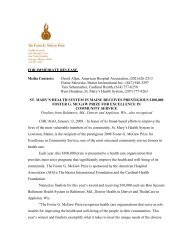EXTRANEAL (icodextrin) Peritoneal Dialysis Solution - Baxter
EXTRANEAL (icodextrin) Peritoneal Dialysis Solution - Baxter
EXTRANEAL (icodextrin) Peritoneal Dialysis Solution - Baxter
Create successful ePaper yourself
Turn your PDF publications into a flip-book with our unique Google optimized e-Paper software.
Geriatric Use<br />
No formal studies were specifically carried out in the geriatric population. However, 140 of<br />
the patients in clinical studies of <strong>EXTRANEAL</strong> were age 65 or older, with 28 of the patients<br />
age 75 or older. No overall differences in safety or effectiveness were observed between<br />
these patients and patients under age 65. Although clinical experience has not identified<br />
differences in responses between the elderly and younger patients, greater sensitivity of<br />
some older individuals cannot be ruled out.<br />
ADVERSE REACTIONS<br />
Clinical Trials<br />
Because clinical trials are conducted under widely varying conditions, adverse reaction<br />
rates observed in clinical trials of a drug cannot be compared to rates in the clinical trials<br />
of another drug and may not reflect the rates observed in practice. The adverse reaction<br />
information from clinical trials does, however, provide a basis for identifying the adverse<br />
events that appear to be related to drug use and for approximating rates.<br />
<strong>EXTRANEAL</strong> was originally studied in controlled clinical trials of 493 patients with<br />
end-stage renal disease who received a single daily exchange of <strong>EXTRANEAL</strong> for the long<br />
dwell (8- to 16- hours). There were 215 patients exposed for at least 6 months and<br />
155 patients exposed for at least one year. The population was 18-83 years of age,<br />
56% male and 44% female, 73% Caucasian, 18% Black, 4% Asian, 3% Hispanic, and<br />
it included patients with the following comorbid conditions: 27% diabetes,<br />
49% hypertension and 23% hypertensive nephropathy.<br />
Rash was the most frequently occurring <strong>EXTRANEAL</strong>-related adverse event (5.5%,<br />
<strong>EXTRANEAL</strong>; 1.7% Control). Seven patients on <strong>EXTRANEAL</strong> discontinued treatment due to<br />
rash, and one patient on <strong>EXTRANEAL</strong> discontinued due to exfoliative dermatitis. The rash<br />
typically appeared within the first three weeks of treatment and resolved with treatment<br />
discontinuation or, in some patients, with continued treatment.<br />
Female patients reported a higher incidence of skin events, including rash, in both<br />
<strong>EXTRANEAL</strong> and dextrose control treatment groups.<br />
Table 1 shows the adverse events reported in these clinical studies, regardless of causality,<br />
occurring in ≥ 5% of patients and more common on <strong>EXTRANEAL</strong> than control.<br />
Adverse reactions reported with an incidence of > 5% and at least as common on<br />
dextrose control included pain, asthenia, exit site infection, infection, back pain,<br />
hypotension, diarrhea, vomiting, nausea/vomiting, anemia, peripheral edema, hypokalemia,<br />
hyperphosphatemia, hypoproteinemia, hypervolemia, arthralgia, dizziness, dyspnea, skin<br />
disorder, pruritis.<br />
Additional adverse events occurring at an incidence of < 5% and that may or may not<br />
have been related to <strong>EXTRANEAL</strong> include: pain on infusion, abdominal enlargement,<br />
cloudy effluent, ultrafiltration decrease, postural hypotension, heart failure, hyponatremia,<br />
hypochloremia, hypercalcemia, hypoglycemia, alkaline phosphatase increase, SGPT<br />
increase, SGOT increase, cramping, confusion, lung edema, facial edema, exfoliative<br />
dermatitis, eczema, vesicobullous rash, maculopapular rash, erythema multiforme. All<br />
reported events are included in the list except those already listed in Table 1 or the<br />
following two paragraphs, those not plausibly associated with <strong>EXTRANEAL</strong>, and those that<br />
were associated with the condition being treated or related to the dialysis procedure.<br />
<strong>EXTRANEAL</strong> was additionally studied in a subpopulation of 92 high average/high<br />
transporter APD patients in a two-week controlled clinical trial where patients received a<br />
single daily exchange of <strong>EXTRANEAL</strong> (n=47) or dextrose control (n=45) for the long dwell<br />
(14 ± 2 hours). Consistent with the data reported in the original trials of <strong>EXTRANEAL</strong>, rash<br />
was the most frequently occurring event.<br />
<strong>Peritoneal</strong> <strong>Dialysis</strong>-Related<br />
Adverse events common to the peritoneal dialysis, including peritonitis, infection around<br />
the catheter, fluid and electrolyte imbalance, and pain, were observed at a similar<br />
frequency with <strong>EXTRANEAL</strong> and Controls (See PRECAUTIONS).<br />
Changes in Alkaline Phosphatase and Serum Electrolytes<br />
An increase in mean serum alkaline phosphatase has been observed in clinical studies of<br />
ESRD patients receiving <strong>EXTRANEAL</strong>. No associated increases in other liver chemistry<br />
tests were observed. Serum alkaline phosphatase levels did not show progressive increase<br />
over a 12-month study period. Levels returned to normal approximately two weeks after<br />
discontinuation of <strong>EXTRANEAL</strong>.<br />
Decreases in serum sodium and chloride have been observed in patients using<br />
<strong>EXTRANEAL</strong>. The declines in serum sodium and chloride may be related to dilution<br />
resulting from the presence of <strong>icodextrin</strong> metabolites in plasma. Although these decreases<br />
have been small and clinically unimportant, monitoring of patients’ serum electrolyte levels<br />
as part of routine blood chemistry testing is recommended.<br />
-4-<br />
Post-Marketing<br />
The following adverse reactions have been identified during post-approval use of<br />
<strong>EXTRANEAL</strong>. Because these reactions are reported voluntarily from a population of<br />
uncertain size, it is not possible to estimate their frequency reliably or to establish a causal<br />
relationship to drug exposure. Adverse reactions are listed by MedDRA System Order Class<br />
(SOC), followed by Preferred Term in order of severity.<br />
INFECTIONS AND INFESTATIONS: Fungal peritonitis, Peritonitis bacterial, Catheter site<br />
infection, Catheter related infection<br />
BLOOD AND LYMPHATIC SYSTEM DISORDERS: Thrombocytopenia, Leukopenia<br />
IMMUNE SYSTEM DISORDERS: Serum sickness, Hypersensitivity<br />
METABOLISM AND NUTRITION DISORDERS: Shock hypoglycemia, Fluid overload, Fluid<br />
imbalance<br />
NERVOUS SYSTEM DISORDERS: Hypoglycemic coma, Burning sensation<br />
EYE DISORDERS: Vision blurred<br />
RESPIRATORY, THORACIC, AND MEDIASTINAL DISORDERS: Bronchospasm, Stridor<br />
GASTROINTESTINAL DISORDERS: Sclerosing encapsulating peritonitis, Aseptic peritonitis,<br />
<strong>Peritoneal</strong> cloudy effluent, Ileus, Ascites, Inguinal hernia, Abdominal discomfort<br />
SKIN AND SUBCUTANEOUS DISORDERS: Toxic epidermal necrolysis, Erythema<br />
multiforme, Angioedema, Urticaria generalized, Toxic skin eruption, Swelling face,<br />
Periorbital edema, Exfoliative rash, Skin exfoliation, Prurigo, Rash (including macular,<br />
papular, erythematous, exfoliative), Dermatitis (including allergic and contact), Drug<br />
eruption, Erythema, Onychomadesis, Skin chapped, Blister<br />
MUSCULOSKELETAL, CONNECTIVE TISSUE DISORDERS: Arthralgia, Back pain,<br />
Musculoskeletal pain<br />
REPRODUCTIVE SYSTEM AND BREAST DISORDERS: Penile edema, Scrotal edema<br />
GENERAL DISORDERS AND ADMINISTRATIVE SITE CONDITIONS: Discomfort, Pyrexia,<br />
Chills, Malaise, Drug effect decreased, Drug ineffective, Catheter site erythema, Catheter<br />
site inflammation, Infusion related reaction (including Infusion site pain, Instillation site<br />
pain)<br />
DRUG ABUSE AND DEPENDENCE<br />
There has been no observed potential of drug abuse or dependence with <strong>EXTRANEAL</strong>.<br />
OVERDOSAGE<br />
No data are available on experiences of overdosage with <strong>EXTRANEAL</strong>. Overdosage<br />
of <strong>EXTRANEAL</strong> would be expected to result in higher levels of serum <strong>icodextrin</strong> and<br />
metabolites, but it is not known what signs or symptoms might be caused by exposure<br />
in excess of the exposures used in clinical trials. In the event of overdosage with<br />
<strong>EXTRANEAL</strong>, continued peritoneal dialysis with glucose-based solutions should be<br />
provided.<br />
DOSAGE AND ADMINISTRATION<br />
<strong>EXTRANEAL</strong> is intended for intraperitoneal administration only. It should be administered<br />
only as a single daily exchange for the long dwell in continuous ambulatory peritoneal<br />
dialysis or automated peritoneal dialysis. The recommended dwell time is 8- to 16- hours.<br />
Not for intravenous injection.<br />
Patients should be carefully monitored to avoid under- or over-hydration. An accurate<br />
fluid balance record must be kept and the patient’s body weight monitored to avoid<br />
potentially severe consequences including congestive heart failure, volume depletion, and<br />
hypovolemic shock.<br />
Aseptic technique should be used throughout the peritoneal dialysis procedure.<br />
To reduce possible discomfort during administration, solutions may be warmed prior to<br />
use. (See DOSAGE AND ADMINISTRATION, Directions for Use).<br />
<strong>EXTRANEAL</strong> should be administered over a period of 10-20 minutes at a rate that is<br />
comfortable for the patient.<br />
Do not use <strong>EXTRANEAL</strong> if it is cloudy or discolored, if it contains particulate matter, or if<br />
the container is leaky.<br />
Following use, the drained fluid should be inspected for the presence of fibrin or<br />
cloudiness, which may indicate the presence of peritonitis.<br />
For single use only. Discard unused portion.<br />
Addition of Potassium<br />
Potassium is omitted from <strong>EXTRANEAL</strong> solutions because dialysis may be performed to<br />
correct hyperkalemia. In situations where there is a normal serum potassium level or<br />
hypokalemia, the addition of potassium chloride (up to a concentration of 4 mEq/L) may be<br />
indicated to prevent severe hypokalemia. The decision to add potassium chloride should<br />
be made by the physician after careful evaluation of serum potassium.<br />
Addition of Insulin<br />
Addition of insulin to <strong>EXTRANEAL</strong> was evaluated in 6 insulin-dependent diabetic patients<br />
undergoing CAPD for end stage renal disease. No interference of <strong>EXTRANEAL</strong> with insulin<br />
absorption from the peritoneal cavity or with insulin’s ability to control blood glucose<br />
was observed. (See PRECAUTIONS, Drug/Laboratory Test Interactions). Appropriate<br />
monitoring of blood glucose should be performed when initiating <strong>EXTRANEAL</strong> in diabetic<br />
patients and insulin dosage adjusted if needed (See PRECAUTIONS).<br />
Addition of Heparin<br />
No human drug interaction studies with heparin were conducted. In vitro studies<br />
demonstrated no evidence of incompatibility of heparin with <strong>EXTRANEAL</strong>.



